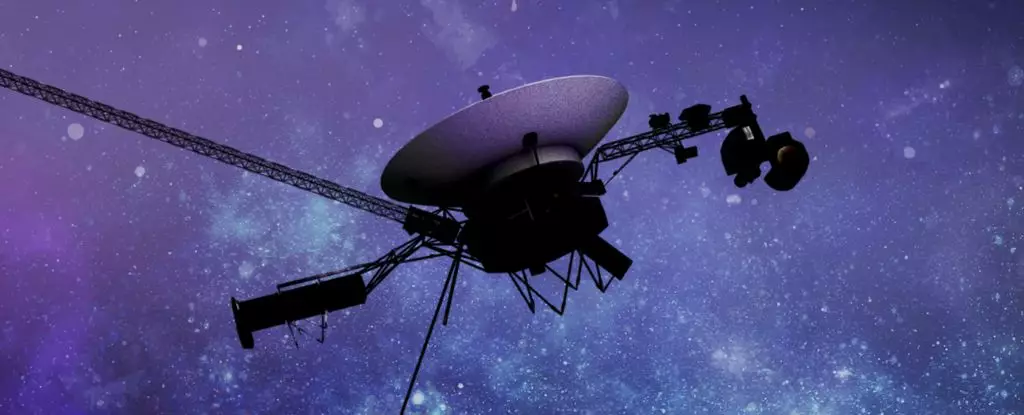Last month, an unexpected hiccup occurred with NASA’s Voyager 1, which continues to traverse the far reaches of interstellar space. This incident serves not only as a reminder of the probe’s isolation but also highlights the challenges involved in maintaining communication with the most distant human-made object from Earth. The communication glitch began on October 16 when NASA transmitted a command to activate one of Voyager 1’s heaters. Paradoxically, this seemingly straightforward request resulted in a two-day radio silence from the probe, illustrating the inherent complexities of deep-space communication and operations.
The time lag is incredible; at a staggering distance of approximately 25 billion kilometers (15.3 billion miles), a signal traveling at the speed of light takes nearly 23 hours to reach the spacecraft, with another nearly 23 hours for a response to come back. Such delays create significant hurdles when troubleshooting inevitable malfunctions. On October 18, when Voyager 1 failed to reply to its scheduled signal, NASA’sDeep Space Network (DSN) began to investigate the issue but took time to pinpoint the root cause of the failure.
NASA discovered that Voyager 1’s built-in fault protection system had been triggered by the heater activation, which leads to an automatic shutdown of non-essential systems in a bid to conserve energy. This mechanism is designed to ensure the spacecraft continues operating under adverse conditions, but its activation at such a great distance introduces profound complications. The X-band radio transmitter, Voyager 1’s primary communication mode with Earth, was effectively disabled, forcing a switch to the S-band transmitter, a backup that while requiring less power, is weaker and thus more challenging to detect.
When this scenario played out, a segment of the scientific community was understandably anxious. The fact is, Voyager 1 has been relying on the X-band transmitter since its inception. The last time the S-band transmitter was used for communication was in 1981, when the probe was significantly closer to Earth. As the NASA team began their troubleshooting efforts, there was widespread concern that the faint signal from Voyager 1 might not be discernible from 25 billion kilometers away.
Luckily, by October 22, engineers at the DSN managed to re-establish contact with Voyager 1 using the S-band transmitter, confirming its functionality. Although this was a hopeful development, the flight team decided against reactivating the X-band transmitter until they fully understand the cause behind the fault protection system’s interruptions. This situation reflects the delicate balance required in dealing with technology that is nearing half a century old—a notable accomplishment juxtaposed against the escalating frequency of technical issues.
Indeed, this incident isn’t an isolated event; it is part of a continuing pattern of glitches affecting the spacecraft’s operations. For instance, in 2022 Voyager 1 sent back distorted telemetry data due to a transient fault. Moreover, between late 2023 and June 2024, the mission encountered another significant problem where the probe reported meaningless data. Upon investigation, this was attributed to a corrupted chip, raising questions about the aging hardware on board.
Despite these challenges, maintaining the functionality of both Voyager probes is crucial. They are currently voyaging through uncharted interstellar regions, making groundbreaking discoveries that contribute to our understanding of the universe. These probes are on the cusp of revealing the phenomena beyond the influence of our solar system, providing invaluable insights into the broader cosmic environment.
Unfortunately, time is running short for these robotic explorers. With dwindling power supplies, it is anticipated that both Voyager 1 and its twin, Voyager 2, will cease to collect scientific data after 2025. As the years progress, the likelihood of losing contact rises, with 2036 marking a critical year when both probes are expected to be beyond the range of Earth-based communication systems. The Voyagers will then continue their solitary journey, drifting through the cosmos and eventually venturing into the enigmatic Oort Cloud.
When we consider that in approximately 40,000 years, the Voyagers will come within two light-years of neighboring stars, it is evident that they will continue to be enduring symbols of human achievement and resilience. Slowly drifting into the infinite, they carry with them the remnants of human culture, a message in a bottle sent into the vastness of space. Ultimately, the story of Voyager 1 serves as a testament to the triumphs and tribulations of exploration, reminding us that, even through adversity, the human spirit continues to reach for the stars.

